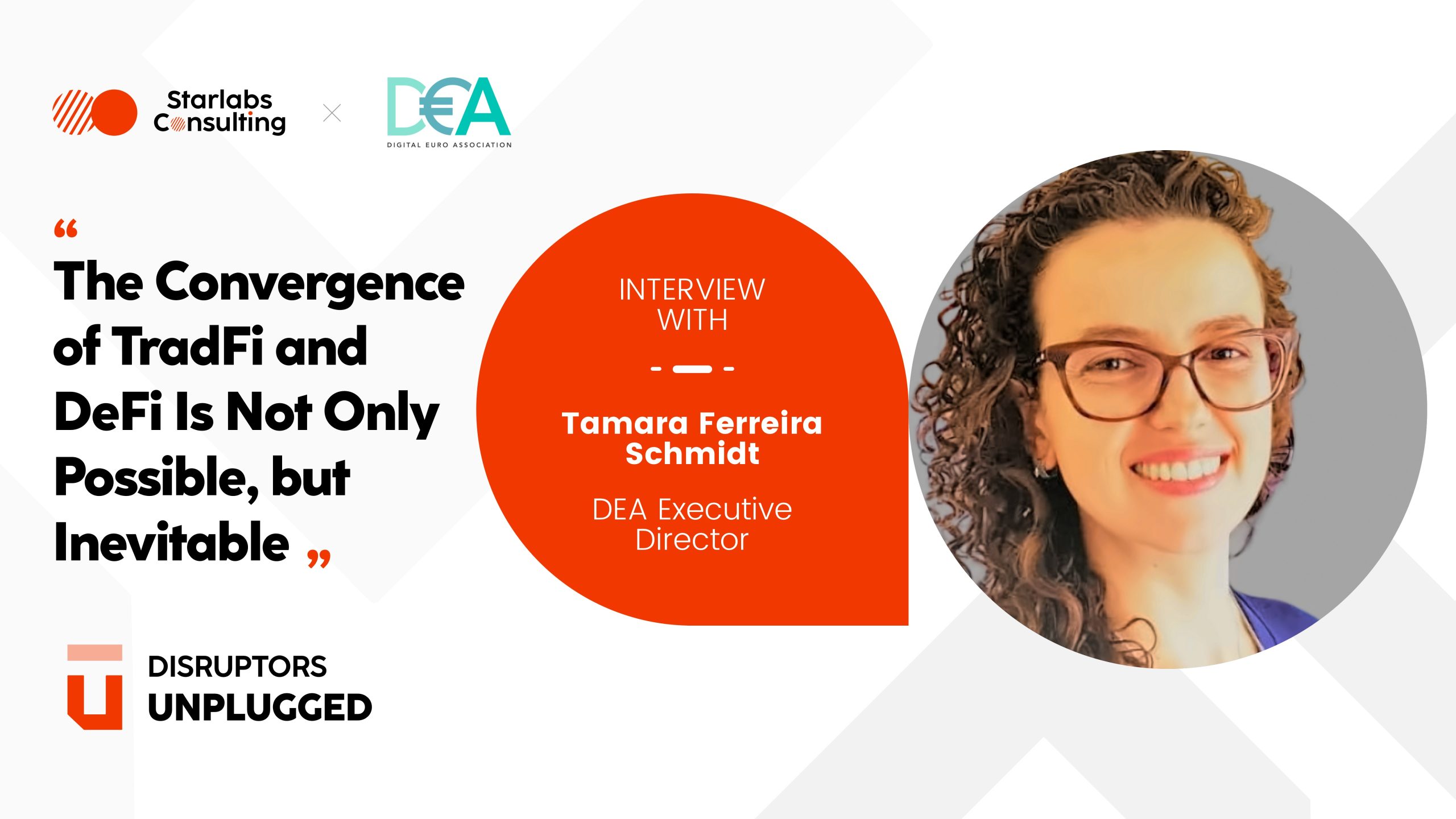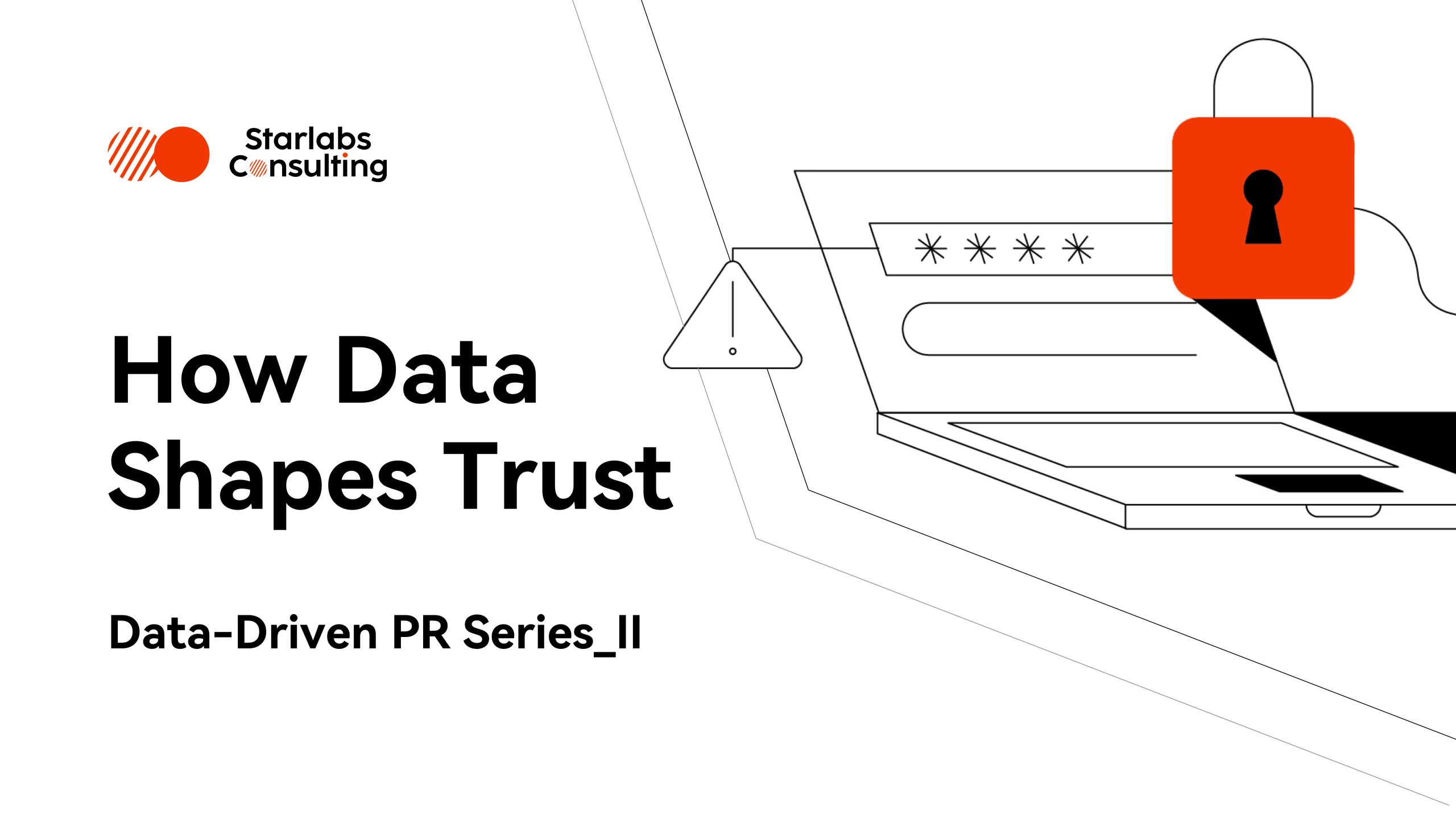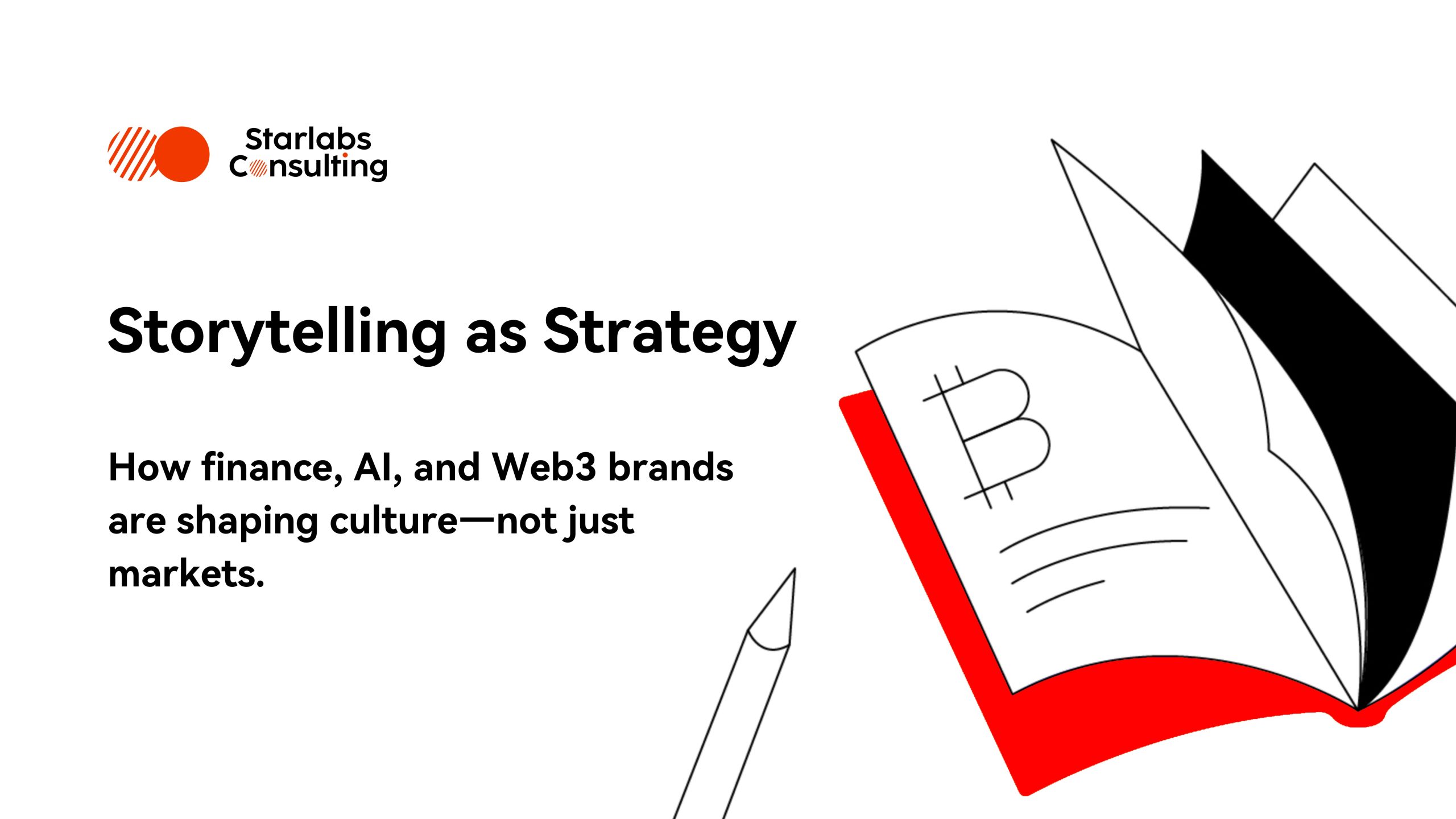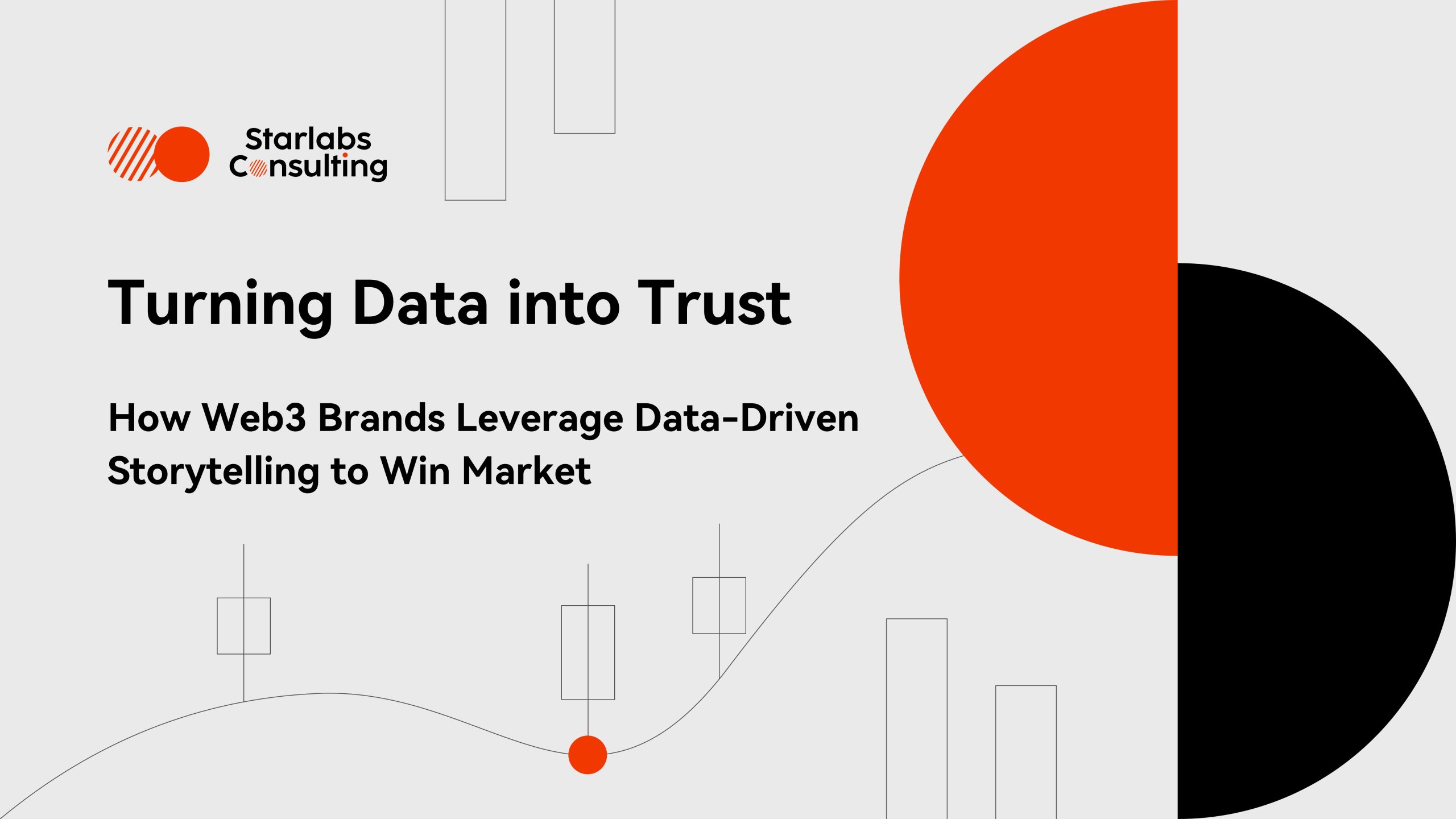
“Integration of TradFi and DeFi: Not Just Possible—But Inevitable”: DEA Executive Director Tamara Ferreira Schmidt
The Digital Euro Conference 2025 wrapped up on March 27 in Frankfurt—long known as the Heart of European Finance. As an official partner, Starlabs Consulting was pleased to be part of the Digital Euro Conference 2025, which brought together policymakers, central bankers, technology leaders, and innovators to discuss the rapidly evolving digital currency landscape.
Among the standout voices at the event was Tamara Ferreira Schmidt, Executive Director of the Digital Euro Association (DEA), which served as the primary organizer. DEA continues to play a critical role in convening cross-sector dialogue on central bank digital currencies (CBDCs), stablecoins, commercial bank tokens, and the broader future of crypto-finance.
Left: Tamara Ferreira Schmidt, Executive Director of the Digital Euro Association (DEA)
A Cross-Disciplinary Leader Driving Financial Transformation
Tamara’s professional trajectory reflects a rare blend of academic rigor and practical innovation. Trained in physics, she later transitioned into financial markets, where she has spent over 15 years specializing in Financial Engineering, Capital Markets, and Derivatives.
She was awarded the German Chancellor Fellowship by the Alexander von Humboldt Foundation for her comparative research on early-stage financing ecosystems in Brazil and Germany. Today, she stands at the intersection of policy, innovation, and investment—consulting and creating content on digital assets, blockchain, startups, and alternative finance. Her speaking engagements span high-profile platforms such as TEDx KanzlerPark, Web 3.0 Disruptors Week, Brussels Blockchain Week, CBDC Conference and the Nordic Blockchain Conference.
Disruptors Unplugged: A Deep Dive on the Future of Finance
In this edition of Disruptors Unplugged, Starlabs Consulting had a discussion with Ms. Schmidt to explore the evolving intersection of traditional finance (TradFi) and decentralized finance (DeFi). Drawing on her perspectives as a practitioner, researcher, and ecosystem builder, the conversation addressed the following key themes:
- The role of tokenization and alternative financing in unlocking capital.
- How CBDCs, stablecoins, and cryptocurrencies are reshaping monetary structures.
- Strategic insights for Web3 ventures entering the European and emerging markets.
- Inclusive innovation: enabling female participation in the digital asset economy.
Key Takeaways
- Alternative financing is really about unlocking capital outside of the conventional banking environment. Tokenization takes that even further by fractionalizing ownership, removing intermediaries, and enabling global, around-the-clock liquidity.
- Women can thrive in Web3 and digital finance by combining curiosity with strategic focus—building technical fluency, understanding regulation, and leveraging networks to drive meaningful impact in a rapidly evolving industry.
- CBDCs present a distinctive value proposition by combining the stability of central bank money with the programmability and efficiency of digital assets. Rather than replacing existing systems, CBDCs are designed to enhance the resilience, inclusivity, and sovereignty of the monetary system in the digital era.
- The EU is looking beyond crypto as just a new asset class and is also considering how tokenization and distributed ledger technology can reshape traditional financial infrastructure.
- Emerging markets present some of the biggest opportunities for digital assets, not because they’re behind, but because they have the potential to bypass traditional systems entirely.
_________
1. Your career is both diverse and impressive. When did you first get involved in the blockchain field, and what initially sparked your interest in blockchain and digital assets?
Schmidt:I initially became interested in the blockchain industry back in 2016 when pursuing my master’s, where I researched how blockchain technology might be applied on the Brazilian stock exchange, B3. At B3, where I was working at the time, I was particularly impressed by the huge potential that the technology had to reshape the financial industry, especially the fundamental infrastructure made available by exchanges, such as trading, custody, and depositary services. It was that kind of moment where you see the technology is no longer a buzzword, but could actually really reshape financial markets.
2. How do you view the relationship between TradFi (traditional finance) and DeFi (decentralized finance)? Do you believe they can coexist, merge, or complement each other?
Schmidt:I see convergence between traditional finance (TradFi) and decentralized finance (DeFi) as not just possible, but inevitable. This isn’t because the two are naturally aligned, but because user expectations are evolving rapidly. People now expect financial services that are faster, more affordable, and broadly accessible. Neither TradFi nor DeFi can fully meet those demands alone. TradFi brings scale, regulatory compliance, and institutional trust. DeFi offers speed, composability, and programmability. The real innovation lies in connecting these strengths by tokenizing assets with legal clarity, integrating smart contracts into financial infrastructure, and creating regulated access to decentralized markets.
DeFi isn’t about replacing TradFi. It’s about enabling streamlined processes and expanding access, even to non-financial assets like intellectual property or digital art. It addresses long-standing challenges such as counterparty risk through tools like automation, decentralization, and transparency. That doesn’t mean eliminating third parties entirely. Instead, it redefines their roles. Banks, for instance, could evolve into access points for DeFi protocols, much like they connect to centralized exchanges today.
For tokenized traditional assets to succeed in decentralized environments, collaboration is essential. We need regulatory bridges, common standards, and strong technical integrations. The future of finance won’t be about choosing sides. It will be about building a cohesive, interoperable system where innovation and trust support one another.
“The future of finance won’t be about choosing sides. It will be about building a cohesive, interoperable system where innovation and trust support one another.”
— Tamara Ferreira Schmidt
3. Throughout your career and research journey, the term “alternative financing” has come up frequently. Could you explain what it means? Do you think tokenization could serve as an ideal form of alternative financing?
Schmidt:Alternative financing is really about unlocking capital outside of the conventional banking environment. This includes models like crowdinvesting, crowdfunding, peer-to-peer lending, invoice financing, and increasingly, tokenization. It’s about making finance more accessible, especially for underbanked or underserved groups such as small and medium enterprises, creatives, or early-stage ventures that often fall outside traditional credit systems.
In my research, I explored how alternative finance developed in response to inefficiencies in traditional capital markets. Digital platforms have helped connect capital with opportunity in new ways. Tokenization takes that even further by fractionalizing ownership, removing intermediaries, and enabling global, around-the-clock liquidity. Imagine a small business raising funds through tokenized revenue-sharing agreements or a community solar project that is securitized and traded globally in micro-shares, all managed through smart contracts.
Of course, this is still an emerging space. The technology is evolving quickly, but regulation and infrastructure have yet to catch up. What we need are frameworks that are intuitive, legally robust, and inclusive. The potential here is immense; not just to improve the way finance operates, but to broaden access to who can take part in it.
4. Could you share more about DEA’s mission, its primary activities, and its long-term vision?
DEA official website
Schmidt:Our mission at the Digital Euro Association (DEA) is to shape the future of digital money by connecting the spheres of policy, technology, and society. While the Digital Euro is a central focus, our work extends well beyond it. We explore the entire digital money ecosystem, including central bank digital currencies (CBDCs), stablecoins, tokenized deposits, and other kinds of digital money.
We bring together a wide range of stakeholders, from central banks and regulators to fintech innovators, academics, and members of civil society. Our aim is to foster dialogue, generate research, and support effective policy-making.
Through working groups, publications, events, and strategic partnerships, we are committed to helping Europe become a global leader in digital money innovation, grounded in transparency, inclusivity, and technological autonomy.
Ultimately, our vision is for the future of money in Europe to be both forward-looking and aligned with democratic values. That means building new infrastructure that places people, privacy, and trust at its core.
“Through working groups, publications, events, and strategic partnerships, we (DEA) are committed to helping Europe become a global leader in digital money innovation, grounded in transparency, inclusivity, and technological autonomy.”
— Tamara Ferreira Schmidt
5. In your opinion, what unique benefits do CBDCs, such as the Digital Euro, offer that are not provided by traditional currencies (like the Euro, US dollar), cryptocurrencies, or stablecoins?
Schmidt: CBDCs present a distinctive value proposition by combining the stability of central bank money with the programmability and efficiency of digital assets. Unlike stablecoins, they carry no issuer risk. Unlike cash, they are ready for automation, work offline, and integrate easily with digital platforms. And unlike cryptocurrencies, they are grounded in public trust and backed by monetary policy.
What sets CBDCs apart is their comprehensive design. They are being developed with all three core elements of a payment system in mind: the instrument, the infrastructure, and the scheme. Most e-money systems focus mainly on the instrument, such as prepaid cards or digital wallets like PayPal and Revolut. Fast payment systems, in contrast, emphasize the infrastructure and how private actors connect. CBDCs aim to unify all of these components into a complete, state-backed system.
This integrated approach means CBDCs are more than just a digital version of cash. If they are developed with care, prioritizing privacy, offline usability, and seamless interoperability, they can form the foundational layer of public digital money. Rather than replacing existing systems, CBDCs are designed to enhance the resilience, inclusivity, and sovereignty of the monetary system in the digital era.
6. China’s CBDC project seems to have faced challenges, and the Trump administration opposed the idea of introducing a U.S. CBDC. How do you interpret these developments? How will the Digital Euro differentiate itself?
Schmidt:China’s initial head start revealed what is possible with scale, but also how political design impacts outcomes, particularly when it comes to privacy. US reluctance stems from a mix of ideological resistance and legitimate concerns about centralized control. The Digital Euro will be Europe’s attempt to find a middle ground, protecting individual freedoms, maintaining financial stability, and steering clear of excessive state power.
7. We’re seeing stablecoins gaining momentum globally. What’s your view on the future of stablecoins in the EU—particularly in terms of market acceptance and regulatory policies?
Schmidt:The Markets in Crypto-Assets Regulation (MiCAR) has laid the groundwork for a more consistent and predictable environment in the EU. Stablecoin issuers need to meet clear standards on reserve backing, governance, transparency, and risk management. This brings much-needed legal certainty and is a welcome step, as well-regulated stablecoins can offer real value in the financial system.
Euro-denominated stablecoins are likely to become key tools in areas like B2B payments, remittances, DeFi, and digital marketplaces. They combine crypto’s speed with the price stability of fiat, a strong proposition for businesses and consumers.
But success won’t go to the most technically advanced projects alone. It will go to those that align innovation with compliance, earn regulatory trust, and integrate smoothly with existing financial infrastructure. In a tightly regulated market like the EU, regulatory approval is no longer a hurdle, it’s a competitive edge.
“Success won’t go to the most technically advanced projects alone. It will go to those that align innovation with compliance, earn regulatory trust, and integrate smoothly with existing financial infrastructure. In a tightly regulated market like the EU, regulatory approval is no longer a hurdle, it’s a competitive edge.”
— Tamara Ferreira Schmidt
8. Could you briefly outline Europe’s regulatory approach and trends regarding digital assets and cryptocurrencies?
Schmidt:Europe is taking a clearly regulation-first approach. A move that can frustrate fast-paced innovators but is ultimately laying down a strong and credible foundation. The EU’s goal is to create a safe, consistent, and innovation-friendly environment for digital assets, and the MiCAR is a major milestone on that path.
It delivers essential legal clarity, covering everything from asset-backed stablecoins to crypto-asset service providers, and establishes a single regulatory framework across all 27 member states.
But MiCAR is only the beginning. The DLT pilot regime is another key development, allowing market participants to test tokenized securities in a regulated sandbox. This shows that the EU is looking beyond crypto as just a new asset class and is also considering how tokenization and distributed ledger technology can reshape traditional financial infrastructure.
Looking ahead, we can expect future regulations to address areas like tokenized deposits, decentralized finance, and wholesale CBDCs. The broader trend is toward rules that are based on activity rather than entities, that are tech-neutral
instead of overly specific, and that aim for harmonization across jurisdictions rather than fragmentation.
While this approach may feel slow, it is building the kind of long-term legal certainty and institutional stability needed to support serious engagement with digital assets.
9. If a Web3 company were looking to expand its market and customer base in Europe, what practical advice would you offer?
Schmidt: Start by understanding the regulatory context. With MiCAR in place, Europe is moving toward a harmonized framework that demands serious attention to compliance. Companies need to assess where their offering fits legally and adapt accordingly.
Localization matters as well. It’s not just about language or currency, but understanding how users across European markets think about trust, money, and data. Partnering with local experts or firms can make regulatory integration and market positioning much smoother.
It’s also worth engaging early, not just with customers, but with regulators and ecosystem players. Organizations like the Digital Euro Association can help bridge that gap, connecting innovators with policy and research communities.
Europe can be a complex market, but for those willing to put in the groundwork, the opportunity is real.
10. You are also well-versed in Brazil’s financial market. What opportunities do you see for digital assets in emerging markets? Similarly, what practical advice would you give to Web3 entrepreneurs aiming to acquire customers in regions like South America, Africa, the Middle East, or Asia?
Schmidt:Emerging markets present some of the biggest opportunities for digital assets, not because they’re behind, but because they have the potential to bypass traditional systems entirely. We have already seen this with mobile banking, where countries like Kenya and Brazil have outpaced many developed economies in both adoption and innovation. The same trend is playing out in digital assets and decentralized finance.
Take Brazil as an example. The introduction of Pix has transformed real-time payments, and with Drex, the central bank’s digital real initiative, Brazil is exploring how tokenized deposits and programmable money could reshape its financial infrastructure. These are not just incremental improvements. They represent foundational change.
That said, Web3 entrepreneurs should be cautious about applying one-size-fits-all approaches. The challenges in these markets are real, ranging from currency volatility and limited access to credit, to underdeveloped capital markets and high remittance costs. But these challenges are also highly specific to each local context. The key to success is listening before building. Focus on solving real, local problems rather than prioritizing technical elegance.
Working closely with local partners, whether they are fintech startups, community organizations, or regulators, can open doors that external solutions often cannot. This is not just about exporting technology. It is about fostering financial resilience and agency in ways that reflect local realities.
11. In recent years, we’ve seen an increasing number of women, yourself included, make significant strides in the Web3 and digital finance space. What guidance would you offer to women looking to build a career in fintech or digital assets? And given the pace of change and inherent uncertainties in this field, would you encourage them to pursue this dynamic path?
Schmidt:Yes, I would, but with a realistic and clear view. The fintech and digital assets space holds a lot of promise, but it is also complex, fast-moving, and often challenging to navigate. A technical background can certainly be helpful, but it is not essential. My own journey began in physics, moved through traditional financial markets, and eventually expanded into blockchain and decentralized finance. That interdisciplinary path has given me the ability to work across both technical and institutional aspects of the industry and to bridge the gap between them when needed.
For women considering a career in this field, I recommend focusing on a few core areas. Build a solid understanding of key technologies, stay informed about the changing regulatory landscape, and identify where your particular skills can add value. It is not about mastering everything at once, but about learning with intention and positioning yourself strategically.
“For women considering a career in this field, I recommend focusing on a few core areas. Build a solid understanding of key technologies, stay informed about the changing regulatory landscape, and identify where your particular skills can add value. It is not about mastering everything at once, but about learning with intention and positioning yourself strategically.”
— Tamara Ferreira Schmidt
I also suggest building a professional network early. This is not just for visibility, but to have a space where ideas, experiences, and honest feedback can be exchanged. That kind of engagement is often essential for personal and professional growth. While the industry still lacks balanced gender representation, especially in leadership, there is room for meaningful contribution, especially from those who bring consistency, critical thinking, and the ability to question assumptions. A strong analytical foundation and a good grasp of how financial systems work are valuable assets in every corner of this space.
You can contact Tamara Ferreira Schmidt via:
- Website: https://tamarafschmidt.com
- Email: contact@tamarafschmidt.com
- LinkedIn: https://www.linkedin.com/in/tamara-schmidt
—-
About “Disruptors Unplugged”
“Disruptors Unplugged” is a Starlabs Consulting Original series that explores disruptive technology through insightful interviews with influential leaders in Web 3.0 and AI. This series features discussions with CEOs, founders, and co-founders who are central to the industry’s evolution, offering a deep dive into its significant impacts, current trends, and future directions. Aimed at a global audience of tech professionals, entrepreneurs, and enthusiasts, “Disruptors Unplugged” aims to enrich understanding, spark innovation, and drive the global discourse on technological progress, positioning itself as a leading platform for discovering the visionary insights and untold stories that are shaping the future of technology.
About Starlabs Consulting
Starlabs Consulting is a global leader in strategic and marketing consulting for the Web3 industry. Founded in 2018, we specialize in delivering end-to-end solutions across strategic planning, financial advisory, PR and marketing, risk forecasting and management, regulatory and legal compliance, crisis management, and innovation research.
We are committed to helping visionary companies navigate complexity in their growth, marketing, and operations — empowering them to thrive in competitive markets. With deep Web3 expertise and an extensive global network, Starlabs Consulting is the trusted partner of choice for many of the world’s leading crypto exchanges. Our professional team is known for its strategic insight, execution excellence, and unwavering client commitment, earning us a strong reputation across the industry.
Website: https://www.starlabsconsulting.com/





